Did China’s One Child Policy Fail To Actually Lower Birth Rates?
What great mystery is this?
"The One Child Policy failed to meaningfully lower birth rates"
If you have a passing interest in demographic trends or China, you've probably encountered this strangely persistent claim. I’ve heard it repeated without much critical examination, often as part of a broadside against the CCP or its policies, or as a critique of coercive birth control in general. There are some quantitative articles that make this argument, and it often finds its way into more legitimate sources (sorry, Our World In Data).
It’s one of those claims that always struck me as obviously wrong, but I only recently looked in enough detail to work out what was going on. Is it true? What really happened during those fateful early years of the one child policy?
Let’s dig in.
Why A Debate?
No-one wants to admit when the Communists are right.
With the requisite deference to their revolutionary forebears, the CCP have naturally wanted to defend their population control policies, claiming that the one-child-policy was necessary, desirable, and achieved its goals. The official line from national demographers is that 400 million births had been averted.
Eager to prove their free-world credentials, many intellectuals inside and outside of China decided to provide a counterpoint, claiming that as well as being unnecessary and inhumane, it was also ineffective. For example, a widely-cited study by Feng, Cai, and Gu (2013) tries to awkwardly thread the needle of “terrible and ineffective”, arguing that “the demographic effects of the one-child policy in reducing population growth, …can at best be very small, [but] the policy’s social effect in depriving a large proportion of Chinese families of a second child is enormous.”
Before diving deeper, take a look at the data for a second, noting how weird it is, and why this argument looks plausible. Starting from 1950, China’s birth rate sort of mirrored Taiwan’s overall trajectory, starting at around 6 births per woman. A classic demographic picture of a rural, agrarian society.
It converges again almost exactly in 1978 with around 2.7 births per woman (mid demographic transition) and again in the 2020s at the East Asian nadir of roughly 1 birth per woman. China’s birthrate trajectory is clearly more erratic, but, superficially, it looks like it follows a similar path to that of Taiwan and South Korea.
Let’s start by looking at China’s weird squiggle. What caused these blips?
The dip caused by the Great Famine from 1957-1960 is easy to explain—it’s hard to have babies when your main calorie sources are tree-bark and belt leather. Then the birth rate recovered in the throes of 1960s socialist enthusiasm, before taking a nose-dive in the 1970s. Finally, there was a weird uptick above its Asian neighbours in the 1980s, despite the implementation of the One Child Policy.
Here we get the paradox… why did birth rates collapse prior to the One Child Policy being implemented in 1979, then not decline during the 1980s?!
The skeptics claim that this must have been a sign that the one-child policy was ineffective. For example, Our World In Data, that China’s fertility rates naturally fell in the 1990s to levels comparable to its East Asian neighbors (emphasis mine):
China’s fertility would have continued to decline even without the One Child Policy, as the rapid fertility drop during the 1970s provides a strong indicator of the country’s natural trajectory. By 2010, fertility would have reached its observed level of around 1.5 children per woman, according to Bayesian models.
Feng, Cai and Gu mention that in similar countries, like South Korea, without a one-child policy “the birth rate also declined, and it declined below the level predicted for China”, so concludes that China’s birth rate would have declined at a similar pace even without the policy during the 1980s and 1990s.
That’s what the data appears to show. In retrospect, the line of China’s birth rate was barely affected by the one-child policy in the 1980s, and has aligned with its closest neighbours, so the policy, they claim, wasn’t actually that effective. It just happens to match East Asian patterns of lower birth rates driven by urbanisation, education, and reduced child mortality—all factors that tend to lower fertility rates. So presumably all these Chinese women only wanted to have a single child to coincide with these trends? Well yes, this makes sense…
Wait, no, it doesn’t! This is insane!
The claim is that stopping literally hundreds of millions of Chinese women from having a second child had almost no effect on fertility decline, because it matches a natural trajectory?! Please think about that for a few seconds before reading on.
I’m fairly well-connected, and know hundreds of Chinese friends, colleagues and acquaintances born between 1980 and 2000 from various provinces. Around 80% of them are only children. Estimates suggest that 50-60% of the population in that cohort are only children, compared to only 12.5% of the previous generation! Even Japanese and South Korean families tend towards two children! Are we really suggesting most families would have voluntarily chosen to have just one child?
Well, obviously not
The answer is simple, but quite interesting.
Fortunately, a statistician called Daniel Goodkind has written quite clearly on this topic. He explains that after China’s pronatalist push in the 1960s, the government pulled a complete 180 in the early 1970s, launching the “later, longer, fewer” “晚、稀、少” campaign, which encouraged later marriage, longer gaps between births, and fewer children overall.
At first glance, this seems like the kind of reasonable policy any country facing high birth rates might implement, with the objective of reducing teen pregnancies, and enabling women to have the number of children they actually want.
But in reality, this policy was really weird! The "Later, Longer, Fewer" campaign was more radical and coercive in driving down birth rates than it gets credit for. We can see the effect of this policy here, compared to some countries with a similar economic trajectory (many of which also had significant birth control policies!), showing how much of an outlier China was.
So what actually happened in the 1970s? There were two main trends that caused the birth rate to drop:
Marriage age. This is the big one. In the 1970s, the minimum marriage age mandated by the “later, longer, fewer” campaign was raised to 28 for urban men and 25 for rural men, with corresponding ages of 25 and 23 for women! This effectively prevented many families who would have otherwise had children in their late teens or early twenties from starting families. In a society where births outside of marriage were heavily stigmatized, delaying marriage meant delaying childbirth.
Campaigns and Social Pressure: When a campaign is launched in 1970s China, you’d better pay attention. The collectivised commune system meant that everyone was tied to a geographical location, where they were under constant scrutiny. This made it nearly impossible to circumvent various marriage and childbirth restrictions. People in villages around the country were being told not to have kids, and the coercive social environment—more extreme than that in the 1980s—meant that there was no private space to get away with either having a baby earlier or not delaying marriage.
So what happened in the 1980s? For my argument to hold—that the One-Child Policy significantly reduced the population—we have to imagine quite a strange counterfactual. We have to imagine that, if China had liberalised its family planning policy in 1980, China’s birth rate would have temporarily rebounded to around 4 births per woman before beginning its “natural decline” in the mid-1980s.
This feels unrealistic, and has never really happened anywhere else, which is why so many people are fooled by the alternative narrative that the policy didn’t work. But accepting this counterfactual is the only explanation that makes sense of that fact that so many people in this generation are singletons, and that the birth rate did not drop substantially. How did it happen?
Well, with the new marriage law, the marriage age dropped instantly to 22 for men and 20 for women, where it remains today. A backlog of couples who had been forced to wait now began having children. These were also China’s 1960s "baby boomers", which was a far bigger generation than those born in the 1950s, reaching childbearing age in the 1980s. These factors were balanced out by the first onslaught of the one-child policy. This is clear from the birth order data:
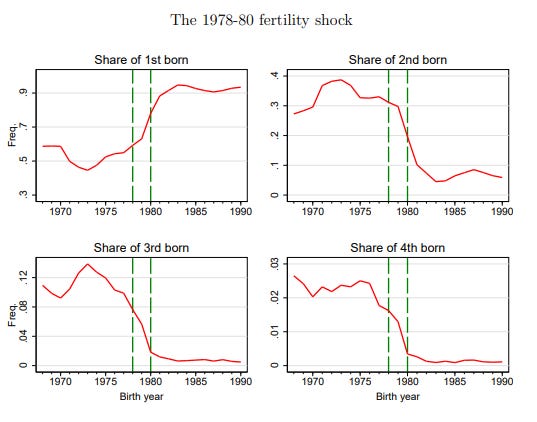
More people were having kids, but far fewer people were having 2nd or 3rd kids! The One Child Policy didn’t initially bring down birth rates because it was introduced alongside the pronatalist policy of allowing earlier marriage, and when China was welcoming a new wave of potential parents. It’s difficult to say whether this was intentional or not, but either way, we know that, had all birth controls been lifted in 1979, the birth rate would have rebounded, therefore the one-child policy was an effective continuation of birth control policies in the 1970s.
It wasn’t until the 1990s, with Jiang Zemin’s new fondness for authoritarianism, and the 1980s “baby bump” well-and-truly over, that the policy’s effects predictably kicked in, with fertility dropping from 2.5 kids per woman in 1990 to 1.5 by 1997. During this period, it looks like the population growth almost perfectly matched the limits allowed by law. Urban households (about 25%) mostly stuck to one child, Han rural households (70%) had one or two kids depending on the gender of the first child and local policies, and ethnic minorities (<5%) averaged over two.
From 1997 to 2017, enforcement became progressively less strict, and we saw a slight rebound to 1.8 kids per woman. As this rebound didn’t result from pro-natalist measures but from the softening of strict limits, this is pretty good evidence that many families wanted more kids throughout the 1990s but were being held back by the policies.
The Counterfactual
What would China be like today without the One-Child Policy?
Let’s just try a back of the envelope calculation for two alternative scenarios:
Scenario 1: Similar family planning policies, just without any “one-child” limitations i.e. most of China restricted to two children
Scenario 2: No family planning policies whatsoever from the 1970s to today
For scenario 1, Feng, Cai, and Gu estimate that 50 million women born between 1961 and 1970 completed their childbearing with only one child. If we assume a similar number for the 1971-1980 cohort, and half of the 1981-1990 cohort (because the policy was lifted half way through their childbearing), this suggests that 125 million families had only one child directly due to the one-child policy.
In the counterfactual, there would have been some only children, but not many, so if we (conservatively) assume that 80% would have had a second child absent this policy, there would be 100 million extra Chinese people aged 15-45 today.
This seems a reasonable estimate of the births directly prevented by the one-child policy, but there would also be second-order effects. The cohort born from 1981-1990 were both the result of, and subject to the one-child policy. Had the 40 million “missing children” from the 1981-1990 cohort been born, they would have had children of their own at a rate of around 1.5 per woman. This would add roughly 30 million to the "missing population" born in the 2010s, bringing the total to 130 million.
I’d add a bit extra due to the normalisation of single-child families in the 2010s and 2020s, and the male-bias, leading to fewer males in later generations, so 150 million seems reasonable. This is a lot higher than the (frankly silly) estimates of some professors, but let’s remember, this is just one small part of China’s population policies from 1970 to today.
For a scenario with a counterfactual of no limitations, we need to go a lot higher.
I haven’t spend the time to carefully model this, but my best guess would look something like this:
As above, we can assume 150 million averted births directly from the one-child policy itself.
We can estimate that delayed marriage and spaced-out births in the 1970s resulted in approximately 80 million missing births. (Total: 230 million)
Since the generation born in the 1970s was smaller than the counterfactual scenario, there would have been knock-on effects on the next generation. Assuming 1.5 generations of averted or delayed births stemming from this period, we add another 120 million. (Total: 350 million)
We can also assume a similar number of "missing" third or fourth children from rural two-child families in the 1980s and 1990s—who likely would have had more children (assuming birthrates in comparable countries of around 3-4 births per woman) without an effective two-child policy in rural areas, and their averted offspring born in the last decade. Let’s add another 100 million. (Total: 450 million)
This is my best guess. China’s population would be around 1.9 billion today, in the absence of population control policies. Feel free to make your own estimates, but I think that anything below 200 million is clearly indefensible, and requires absurd assumptions.
But there are other methods to support my estimate here. You could also compare China to a more closely matched country. East Asia isn’t the best fit. Today, urban China might look a bit like South Korea or Taiwan, but in 1990, it was a different story. By 1990, these richer countries had urbanised, and were now only 25–30% rural ( and as always, the rural population in South had much higher birth rates). In 1990, China was 74% rural. China was also far poorer—its nominal GDP in 1990 was around $1,000 per capita, compared to over $6,000 in South Korea when it had its demographic transition. Comparing China to other East Asian countries without accounting for these massive economic and rural-urban differences is clearly silly.
Vietnam might be a better reference point. It shares cultural similarities with China, liberalised around the same time, and had a similar % of rural population throughout the late 20th century, along with a comparable GDP. Goodkind estimates that, without the One-Child Policy, China’s birth trajectory would have resembled Vietnam’s. He guesses an additional 300–500 million births between 1970 and 2020, which matches my “back-of-the-envelope” calculation.
What does this mean for today?
Here we are in 2025, and China is superficially starting to look more like Korea or Taiwan—especially the urban China that is most commonly shared with the outside world, making that fallacious argument look annoyingly realistic. China’s birth rate has dropped to 1 child per woman—somewhere between Japan and South Korea, but before the country has become as rich as her East Asian neighbours.
As well as the premature population crash, there are two other reasons why almost 50 years of population control policies have continued to shape China’s demographics, and might make the next decade even weirder:
First, the gender imbalance. China saw widespread sex-selective abortion and infanticide throughout the 1980s, which escalated in the 1990s. By 2019, men outnumbered women on the mainland by 31.6 million, and this is heavily concentrated in the generations now of childbearing age. This crazy Wikipedia page shows that some provinces like Jiangxi had 143 boys born from 2001-2005 per every 100 girls! I couldn’t find whether anyone had calculated the impacts of this, but this has to be having a wild effect on birth rates as I write this in the 2020s.
Second, more difficult to pin down, is the cultural impact of a singleton culture. I’m married to a Chinese woman, and we’ve just had our first kid (relatively late). I’m starting to think about the norm from my childhood that I should avoid having an only child. We only had one only-child in our primary school class and she was a bit of an outcast. By contrast, my wife only knew one or two people with siblings when she was growing up, and understandably thinks that having a single child is more normal—it’s just the standard family structure.
The Chinese government is trying to renormalise having a second kid, but I sense that this policy is coming a decade too late. The societal expectations formed during childhood don’t simply shift because of a few murals or multi-child families on state TV. Most Chinese parents aren’t eager to be the outliers with three or four kids, especially when pouring resources into a single child has become the standard. Unless something very drastic changes, I can’t imagine any change happening here.
Opinions
I’ve been agnostic about whether I think China’s population control policies have been a “good thing” or not, which was intentional. Whether it is “good” is tangential to whether it “worked”.
The whole debate around China’s population has been awkward for many intellectuals since the 1980s. Many Western liberal opinion leaders have been through a relatively antinatalist phase since the moral panic around population growth in the 1960s—I know I grew up with a morbid fear of overpopulation, and we can see how few pronatalists there were 10 years ago in this US survey.
But I’ve since read Bryan Caplan, listened to the Collinses’ pronatalist tirades, and, despite the obvious harms of a growing population, have bought into this pronatalist vibe shift. Now with every blogger and his neutered dog writing about the baby bust, and a better understanding of the economics of population growth, fewer people than ever will be shaking their head sagely and bemoaning that China’s policies were a necessary evil.
China’s recent failure to reverse the trends of population decline has coincided with this vibe shift, and, both in China and abroad, the harsh reality of China’s population decline is leading to growing condemnation of 50 years of coercive birth control.
I think the time has come to recognise that China’s population policies were inhumane, coercive, and, even worse, they were effective.


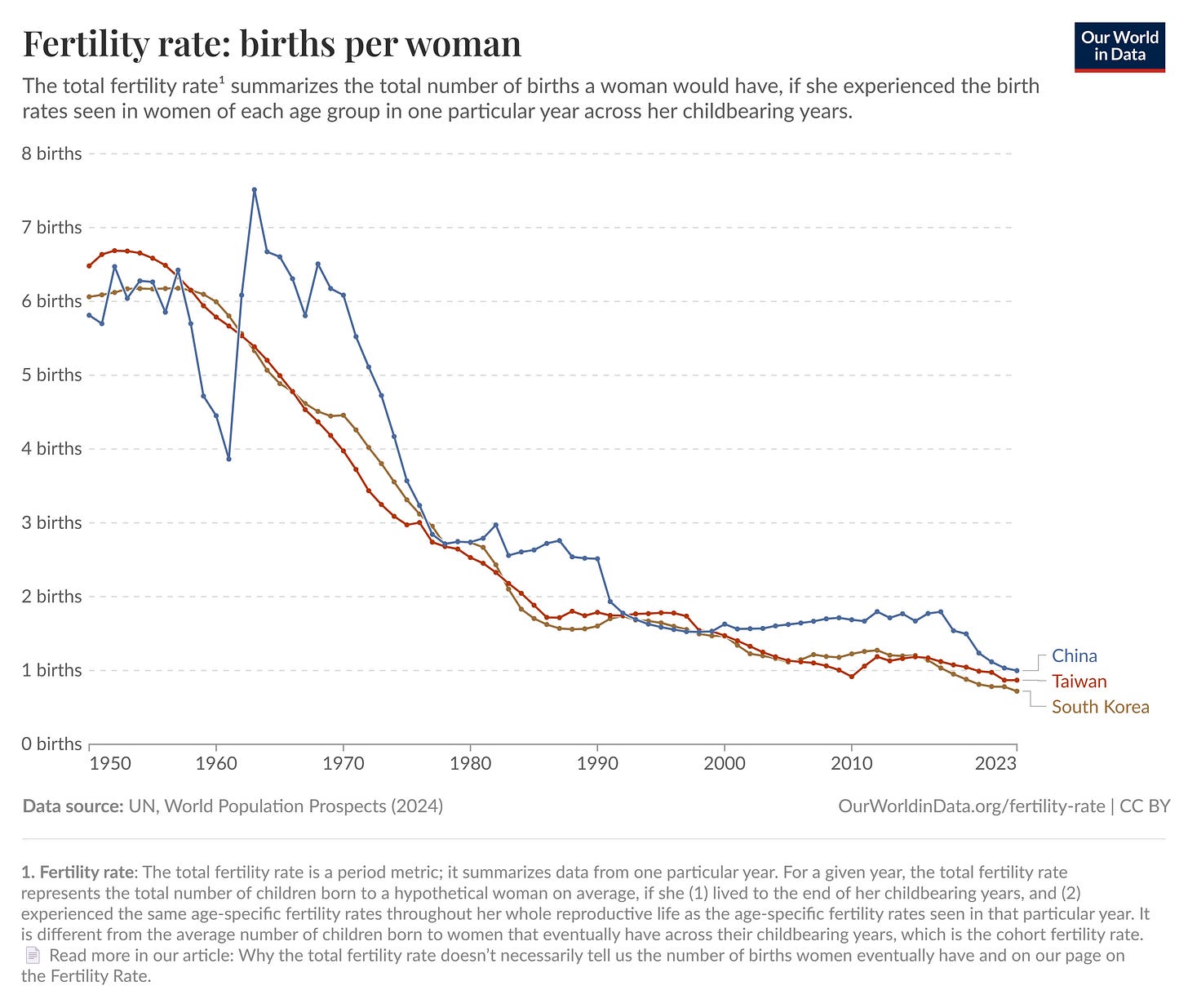
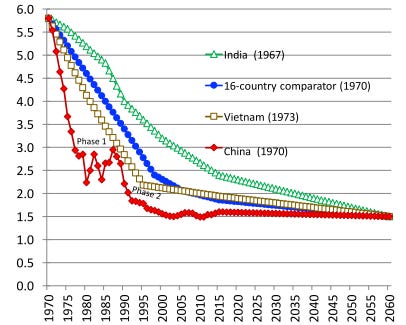

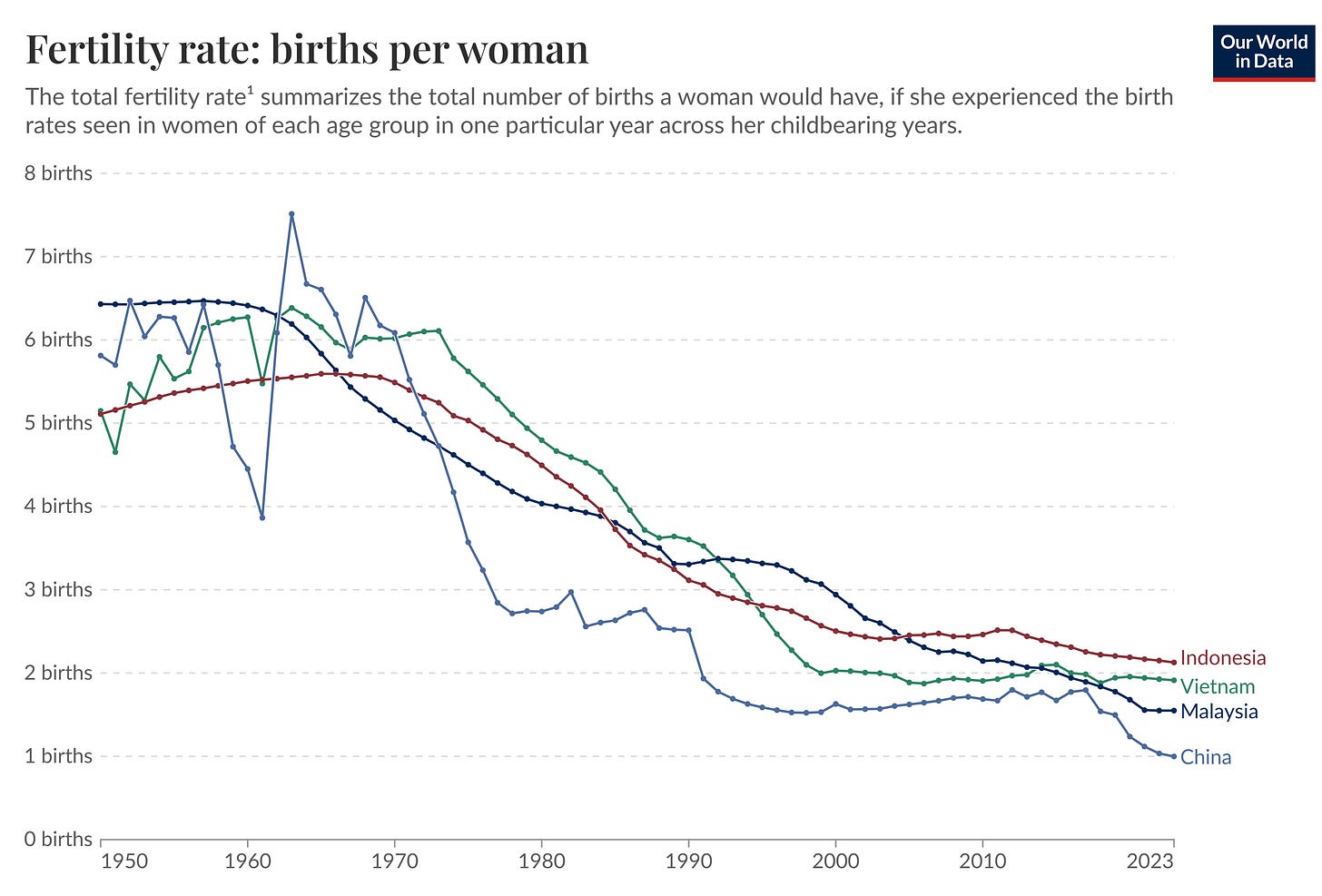
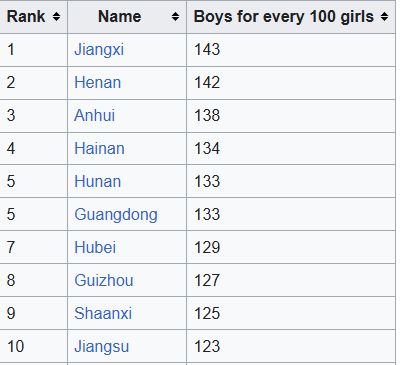

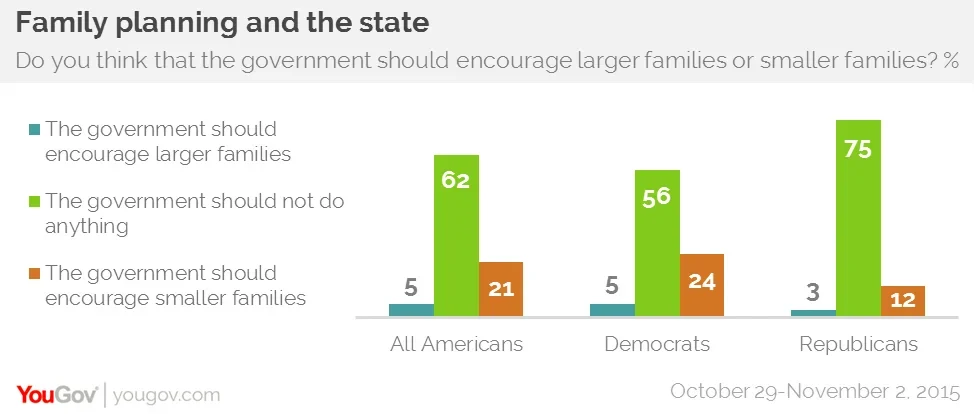
I'd like to have a more incisive question, but I mainly just want to know why the people in the two kids poster look european?